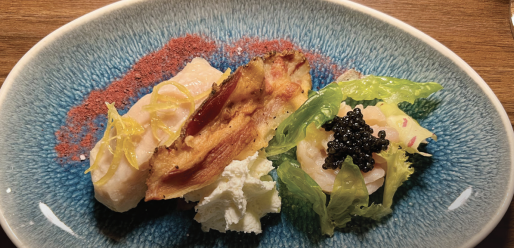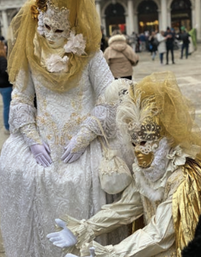Something New Under the Sun
- Jun 30, 2022
- 6 min read
Ca Di Dio, Venice's newest five-star hotel, presents a masterful melding of old and new.
Written by Bridget Williams
"If you read a lot, nothing is as great as you've imagined. Venice is—Venice is better." ~Fran Lebowitz

On the long-haul portion of our flight to Venice (via CDG), I delved into The Venice Sketchbook, an easy and engaging read by Rhys Bowen. The author wove the narrative by alternating between the stories of a young British woman in Venice around World War II and her niece in the present day. The author did such a fabulous job setting the scene that several sights appeared familiar even though it was the first time I'd laid eyes on them.
I have COVID to thank for a much less crowded visit this past February, which also happened to coincide with the start of Carnevale. Lingering restrictions meant more breathing room in places like the famous St. Mark's Square to watch the parade of lavishly costumed revelers. Following the movement of the swarm of onlookers made it easy to locate the most over-the-top ensembles, and I was happy to join the fray seeking a photograph.

We arrived at our hotel, the newly-opened five-star Ca Di Dio, as one should when visiting Venice for the first time (or anytime you can): by motoscafi (water taxi), at the hotel's "side" door. The property sits in the quieter Arsenale district, where the famous Art Biennale is held; it's taking place now through November (labiennale.org/en/ art/2022). We braved the chill to sit in the open-air portion at the back of our motoscafi to watch as the bell tower of Piazza San Marco came closer into view as we transitioned from open lagoon to narrow canals. Instantly enamored, I marveled at how the water, which some argue is cleaner and clearer due to Italy's 2020 lockdown, lapped at doorways like an incessant solicitor.
As an American whose county is a mere 246 years old, learning that portions of Ca Di Dio were erected in the 13th century is just mind-boggling. For reference, during this time, the Crusades were still underway, and Venetian explorer Marco Polo was traveling the Silk Road.
Part of the VRetreats collection, managed by Italy's VOI Hotels, Ca Di Dio's three-story structure has served as a hostel for Crusaders and later as a hospice for women. Spanish architect Patricia Urquiola spearheaded the three-year renovation. Strict historic preservation guidelines prevented changes to the Istrian stone façade dotted with 442 windows and the interior floorplan, resulting in an aura of austere elegance. Juxtaposed with the original features are contemporary building and interior design elements sourced exclusively from Italy, such as the handcrafted Murano glass lamps, Venetian plaster walls, and custom furnishings.

Once the site of an ancient house of worship, the centerpiece of the double-height lobby is a massive chandelier comprised of 14,000 Murano glass tiles designed to evoke the sails of a boat. Old-meets-new as a pair of antique statues peers down from their plinths at sinuous sofas upholstered in colorful velvet.
There are 57 suites and nine deluxe rooms, all sumptuously decorated with custom-made furniture from Molteni & C in a unique style that defies cliché categorization. Our third-floor corner room was one of ten suites offering a view of the lagoon and San Giorgio Maggiore Island. The two largest suites have a staircase leading to a private roof terrace overlooking the San Marco basin.
Following the original contours of the roof, the ceiling height in our sleek suite went from low at the perimeter to vaulted at the center, lending a shape-shifting Alice in Wonderland effect, especially when considered alongside the room's whimsically-shaped Murano light fixtures. I spent a good deal of time trying to locate the promised complimentary minibar and Lavazza espresso machine before finding it concealed cleverly behind wood paneling. A sliding door sheathed in antiqued mirror revealed a spacious walk-in closet. A portion of the walls in the suite are upholstered in the same Venetian Rubelli fabric as the drapery. An expanse of Rosso Verona marble and Venetian plaster walls executed in a complementary hue emanates a sleek, contemporary vibe in the bathroom. The hotel leaves a nightly postcard imprinted with a vintage photo from Camera Photo Epoche's archive in lieu of a traditional turndown sweet.

As we quickly discovered, greenspace is a rarity in a city where buildable land is scarce. This makes Ca Di Dio's courtyard garden, complete with two original wells, a hidden gem for relaxing after a day of exploring. This predominance of private spaces has already made the property a hit among A-list celebrities seeking an under-the-radar sojourn.
Also counted among Ca Di Dio's treasures are its food and beverage program. Comprised of three small rooms, the gold-ceilinged Alchemia Bar appears to be the place for well-heeled Italians to congregate, and with good reason: the cocktails are as exceptional as the convivial bartenders. We became fast friends with bartender Marco Mdolla, a Venetian with palpable enthusiasm for botanically-inspired craft cocktails. If you want to know what to see and where to go that's off the typical tourist beat, just spend a few hours here, and your itinerary for the following days will be complete. It's notable that Alchemia features a line of gins distilled by Zu Plun, and created exclusively for Ca' di Dio in collaboration with The Merchant of Venice. The Sál variety is infused with saltwater from the lagoon.
Following an aperitif and lively conversation at Alchemia Bar, we passed through the lobby and into the cozy wood-paneled reading room to reach VERO, an intimate restaurant. I couldn't keep my eyes off the Jannelli & Volpi wallpapered ceiling, a custom design by Patricia Urquiola inspired by the region's land and sea bounty. Again, the service was exemplary, as was Chef Raimondo Squeo's cuisine, complemented by wine pairings focused on vintners from northeast Italy and served in lovely glasses handcrafted nearby in Murano.
Overlooking the courtyard, Essentia Restaurant offers a more casual atmosphere. It was a must-stop for us before heading out each morning to partake of their European-style buffet and a cappuccino.

Ca di Dio's location in the Castello District, known for its contemporary art scene, is less crowded. Yet, it's still just a 20-minute walk from the perennially packed Rialto Bridge and Piazza San Marco. So, without a hard and fast agenda, we walked, and walked, and walked—most days in excess of ten miles— making frequent pitstops at out-of-the-way bacaris (local bars) to partake of Venetian cicchetti (finger foods), accompanied by an Aperol Spritz. I loved being able to try small bites packed with so many varying flavors from land and sea.
Venice boasts a dizzying array of shops offering wares from kitsch to couture. While we enjoyed fawning over high-end goods, including sumptuous diamond-quilted-leather-wrapped espresso machines at GIOBAGNARA (giobagnara.com) and exquisite Venetian-made linens at Jesurum (jesurum.it/en), it was the smaller shops off the beaten path that we found most intriguing. Spying a shattered rainbow of glass rods on the worktable of artisan Giorgio Nason—whose ancestors are among Murano's original glass-making families—in the window of his studio near the Peggy Guggenheim Collection of Modern Art (guggenheim-venice.it/en), drew us in to admire his work-in-progress and his unique collection of glass jewelry (designs188.com). Despite the proliferation of vendors selling mass-produced masks, less than a dozen shops produce papier-mâché versions in the traditional style. Stepping into a mascarer's workshop immerses you in an environment that's simultaneously cool and creepy.
Wanting to experience an icon, we met friends from Milan at Harry's Bar. Credited with inventing beef carpaccio and the Bellini cocktail, it's known for hosting some of the most famous faces of the 20th century. Two Bellinis each and $211 later, our Italian friends joked that some fleecing of tourists is expected, but that Harry's was next level. They selected Bistrot De Venise (bistrotdevenise.com) for dinner, and we thoroughly enjoyed the restaurant's fresh interpretation of Venetian recipes from the 14th to the 18th centuries. A few other dining options of note include 1000 Gourmet for a dizzying array of pizzas (gruppo1000.it/); Ristorante Da Ivo, an upscale spot frequented by George and Amal Clooney (ristorantedaivo.it/); the quiet and charming Al Covo (ristorantealcovo.com); Antiche Carampane for their takeaway paper cones bursting with fried mixed seafood (antichecarampane.com/en/); and cicchetti at standing-room-only Enoteca Schiavi (cantinaschiavi.com); and Bar All'Arco. Our experience is that you have to work hard to have a bad meal.

The psychology of anticipation means that some destinations don’t live up to expectations. However, reality definitely trumped imagination for my first trip to Venice.
Rooms at Ca Di Dio begin at $800. For more info and reservations, visit vretreats.com/ca-di-dio/.







































Comments